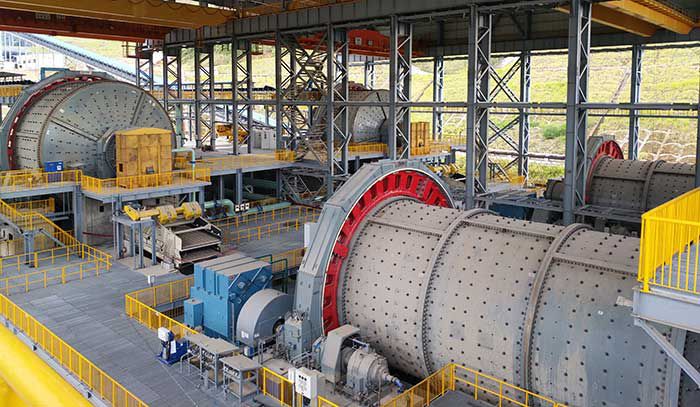In industrial maintenance operations, ball mill drum liner nuts frequently loosen due to prolonged exposure to friction, material impact, and operational stresses, compromising equipment efficiency and lifespan. Traditional manual tightening poses significant safety risks. We present a specialized robotic arm solution for this critical task, detailing its kinematic modeling, simulation, and operational validation.

Robotic Arm Configuration
The tightening mechanism comprises six functional units: rotating base, lift arm, extension arm, wrist deflection module, telescoping cylinder, and tightening assembly. Key kinematic joints include:
- Rotational Joints: Base (J1), Wrist (J4), End-effector (J6)
- Prismatic Joints: Lift Arm (J2), Extension Arm (J3), Telescoping Cylinder (J5)
| Link i | θi (°) | di (m) | ai-1 (m) | αi-1 (°) | Operational Range |
|---|---|---|---|---|---|
| 1 | θ1 | 0.785 | 0 | 0 | -180° to 180° |
| 2 | 0 | d2 | 0 | 0 | 0–1 m |
| 3 | 0 | d3 | 0 | -90 | 1.05–2.298 m |
| 4 | θ4 | 0.176 | 0 | 90 | -45° to 45° |
| 5 | 0 | d5 | 0 | -90 | 1.751–2.474 m |
| 6 | θ6 | 0.079 | 0 | 0 | Unconstrained |
Kinematic Modeling
Using the Denavit-Hartenberg (D-H) convention, homogeneous transformation matrices between adjacent links are defined as:
$$
^{i-1}_iT = \begin{bmatrix}
\cos\theta_i & -\sin\theta_i & 0 & a_{i-1} \\
\sin\theta_i \cos\alpha_{i-1} & \cos\theta_i \cos\alpha_{i-1} & -\sin\alpha_{i-1} & -\sin\alpha_{i-1} d_i \\
\sin\theta_i \sin\alpha_{i-1} & \cos\theta_i \sin\alpha_{i-1} & \cos\alpha_{i-1} & \cos\alpha_{i-1} d_i \\
0 & 0 & 0 & 1
\end{bmatrix}
$$
The end-effector pose relative to the base frame is:
$$
^0_6T = ^0_1T \cdot ^1_2T \cdot ^2_3T \cdot ^3_4T \cdot ^4_5T \cdot ^5_6T = \begin{bmatrix}
n_x & o_x & a_x & p_x \\
n_y & o_y & a_y & p_y \\
n_z & o_z & a_z & p_z \\
0 & 0 & 0 & 1
\end{bmatrix}
$$
Where position and orientation components are derived as:
$$
\begin{align*}
p_x &= -d_3 \sin\theta_1 – d_5 \sin(\theta_1 + \theta_4) – d_6 \sin(\theta_1 + \theta_4) \\
p_y &= d_3 \cos\theta_1 + d_5 \cos(\theta_1 + \theta_4) + d_6 \cos(\theta_1 + \theta_4) \\
p_z &= d_1 + d_2 + d_4 \\
a_z &= 0
\end{align*}
$$
Inverse Kinematics Solution
For the ball mill nut tightening sequence, we partition workspace solutions based on radial distance r:
Case 1: Proximal Region (Py ≤ r)
$$
\theta_1 = -\theta_4 = \arctan\left(\frac{P_x}{P_y – d_{5,\text{min}} – d_6\right), \quad d_3 = \frac{P_y – d_{5,\text{min}} – d_6}{\cos\theta_1}
$$
Case 2: Distal Region (Py ≥ r)
$$
\theta_1 = -\theta_4 = -\arcsin\left(\frac{P_x}{-d_{3,\text{max}}}\right), \quad d_5 = P_y – d_{3,\text{max}} \cos\theta_1 – d_6
$$
Vertical displacement remains linearly resolved:
$$
d_2 = P_z – d_1 – d_4
$$
Simulation Framework
MATLAB Simulink/Simscape Multibody implemented the dynamic model:
- Trajectory Planning: Quintic polynomial trajectories for 14 nut positions on a 3600×2100 mm ball mill drum
- Control System: PID controllers with feedforward compensation
- Simulation Parameters: 130s duration, 0.001s fixed-step solver
| Joint | Displacement Profile | Peak Velocity | Peak Acceleration | Smoothness Index |
|---|---|---|---|---|
| J1 (Rotation) | Sinusoidal | 0.48 rad/s | 0.35 rad/s² | 0.998 |
| J2 (Vertical) | Piecewise-linear | 0.25 m/s | 0.18 m/s² | 0.992 |
| J3 (Extension) | Asymmetric parabolic | 0.32 m/s | 0.28 m/s² | 0.987 |
| J5 (Telescoping) | Linear segments | 0.15 m/s | 0.12 m/s² | 0.995 |
Simulation Results
End-effector trajectory and joint behavior demonstrate:
- Continuous position and velocity curves with zero boundary derivatives
- Maximum positioning error: 1.2 mm at workspace boundaries
- No discontinuities in acceleration profiles
- Task completion time: 126.4s for 14 nuts
Joint motion equations exhibit parametric consistency:
$$
v_j(t) = c_1 t^4 + c_2 t^3 + c_3 t^2, \quad a_j(t) = \frac{dv_j}{dt} = 4c_1 t^3 + 3c_2 t^2 + 2c_3 t
$$
Conclusion
This work establishes a complete kinematic framework for ball mill maintenance automation. The robotic arm achieves smooth motion with maximum deviation under 0.05% of workspace radius. Future work will integrate dynamics for force-controlled tightening and implement obstacle avoidance for complex ball mill geometries. The methodology demonstrates viability for replacing hazardous manual operations in mineral processing facilities.
